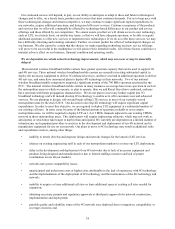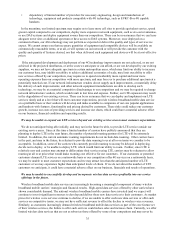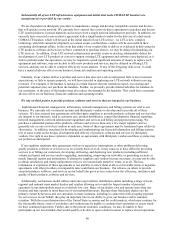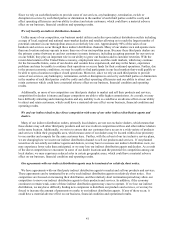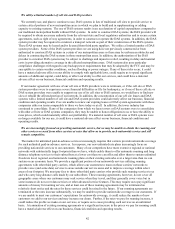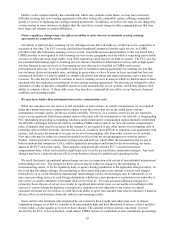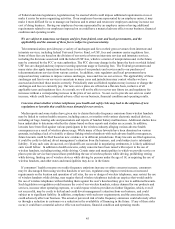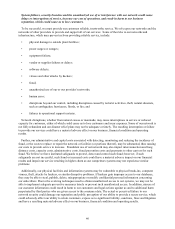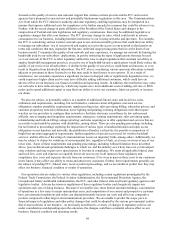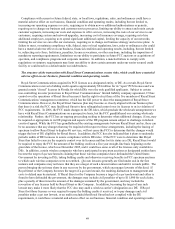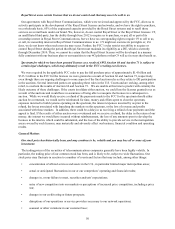Metro PCS 2009 Annual Report Download - page 53
Download and view the complete annual report
Please find page 53 of the 2009 Metro PCS annual report below. You can navigate through the pages in the report by either clicking on the pages listed below, or by using the keyword search tool below to find specific information within the annual report.41
Since we rely on such third parties to provide some of our services, any bankruptcy, termination, switch or
disruption in service by such third parties or diminution in the number of such third parties could be costly and
affect operating efficiencies and our ability to attract and retain customers, which could have a material adverse
effect on our business, financial condition and operating results.
We rely heavily on indirect distribution channels.
Unlike many of our competitors, our business model utilizes and relies upon indirect distribution outlets including
a range of local, regional and national mass-market dealers and retailers allowing us to reach the largest number of
potential customers in our metropolitan areas at a relatively low cost. Approximately 90% of the sales of our
handsets and services occur through these indirect distribution channels. Many of our dealers own and operate more
than one location and may operate in more than one of our metropolitan areas. Because these third party dealers are
the primary contact between us and our customers in many instances, including accepting payment for our services
on our behalf, they play an important role in our ability to grow our business and in customer retention. With the
recent deterioration of the United States economy, employment rates, and the credit markets, which may continue
for the foreseeable future, some of our dealers and vendors have experienced, and may in the future, experience
problems and may be unable to continue their operations or secure funds for their continued operations. Further, due
to the present economic conditions, we may be unable to find participants in our local markets that would qualify or
be able to open a location to replace closed operations. Moreover, since we rely on such third parties to provide
some of our services, any bankruptcy, termination, switch or disruption in service by such third parties or diminution
in the number of such third parties could be costly and affect operating efficiencies and our ability to attract and
retain customers which could have a material adverse effect on our business, financial condition and operating
results.
Additionally, as more of our competitors use third party dealers to market and sell their products and services,
competition for dealers is intense and larger competitors are able to offer higher commissions. As a result, we may
have difficulty attracting and retaining dealers and any inability to do so could have an adverse effect on our ability
to attract and retain customers, which could have a material adverse effect on our business, financial condition and
operating results.
We and our indirect dealers face direct competition with some of our other indirect distribution agents and
dealers.
Many of our indirect distribution outlets, primarily local dealers, are not our exclusive dealers, which means that
these dealers may sell other third party products and services in direct competition with us and other indirect dealers
in the same location. Additionally, we strive to ensure that our customers have access to a wide variety of products
and services within their geographic area, which means some of our dealers may be located within close proximity
to one another and compete for the same customer base. Further, with the advent of our tax inclusive service plans,
we are changing how we incent our indirect distribution channel to sell our products and services. If our planned
incentives do not satisfy our indirect agents and dealers, we may have to increase our indirect distribution costs, we
may experience lower sales than anticipated, or we may lose our indirect distribution agents and dealers. As a result
of the direct competition we encounter in some of our dealer locations and the potential for competition among our
local dealers, we may experience reduced sales in certain geographic areas, which could have a material adverse
effect on our business, financial condition and operating results.
Our agreements with our indirect distribution agents may be terminated on relatively short notice.
We have agreements with our third party indirect distribution agents to market and sell our products and services.
These agreements can be terminated by us or by such indirect distribution agents on relatively short notice. Our
competitors are focused on increasing their distribution, and the relatively short termination period may allow our
competitors to move our indirect distribution agents to their products and services. In addition, if the economy
continues to remain weak, some of these indirect distribution agents may cease to operate. If we lose our indirect
distribution, we may have difficulty finding new companies to distribute our products and services, or we may be
forced to increase the amount of payments we make to our indirect distribution agents. If any of these occur, it
could have a material adverse effect on our business, financial condition and operational results.





